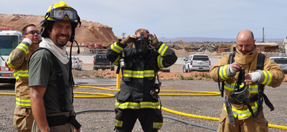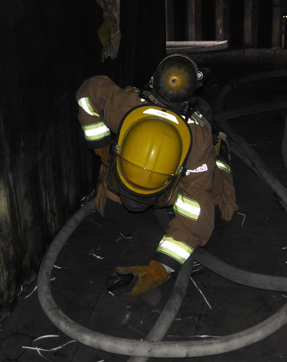This is the first in a series about two structural fire academy candidates, Brandon Penrose and David Robinson, park rangers from Grand Canyon National Park. Their stories have been blended together.
Having no vision and following a hose line to a simulated downed firefighter is harder than it seems. Many things run through your head in mere seconds. Control your breathing. Conserve your air. Am I still on the hose line? How much farther? . . .
Introduction

Structural fire protection is an important part of the National Park Service mission. Entrusted to protect human life and park resources, including buildings, irreplaceable cultural resources, valuable property, and infrastructure, 21 parks maintain active structural fire engine companies, staffed almost entirely with collateral duty employees--people whose main job is something other than firefighting.
In late March 2012, 24 NPS employees traveled to the national structural fire training facility at Glen Canyon NRA to become certified as structural firefighters for the NPS. The 88-hour course taught them the basic skills to fight fires safely and effectively as a member of an engine company. During this academy, we followed the activities of two firefighter candidates, Brandon Penrose and David Robinson, park rangers from Grand Canyon National Park.
Day 1 — The Beginning of a Challenging Adventure
Being a firefighter is a job that many young men and women dream about as they grow up. The reality is that now I have the opportunity to run into a burning building and fight fire that radiates heat up to 3,500 degrees. Sounds fun, right? I imagine that it is exhilarating, but since this is the first day of class, I have a lot to learn.

The day began with an introduction from our instructors, all of whom are seasoned career firefighters. Most of the students, however, all of whose backgrounds were highly diverse, had no applicable firefighting background. This was astounding to me! We are expected to be able to run into burning buildings in two weeks and none of us know what we are doing yet. But our absence of training in structural firefighting is exactly why we are here in the first place. The instructors have clearly stated that this is an entry-level course for those who want to fight structural fires in the national parks. They reiterated that we are not going to learn any skills that are overly complex, but that we will repeat the skills that we do learn, over and over and over again.
The practical portion of the first day consisted of learning how to wear our turnouts, personal protective equipment (PPE), and self-contained breathing apparatus (SCBA). Turnouts are the protective equipment that firefighters wear when responding to fires, vehicle accidents, etc. They consist of heavy rubber boots; pants with suspenders; coat; head covering; SCBA mask; and the unmistakable helmet.

We were timed at donning (putting on) our turnouts within one minute! Then we had to put on our SCBA and be breathing air from the tank in less than an additional minute. No easy task! Afterward, we practiced searching a building for an injured firefighter, while our breathing masks were covered with shrouds that would simulate low to zero visibility on the fire training grounds. While wearing complete turnouts with SCBA tank and breathing compressed air, our vision was blacked out and we were put into an area where we had to follow a hose line to a simulated downed firefighter's personal alert safety system (PASS) device. The PASS device is an annoying, loud, nonstop alert system that activates after 30 seconds when a firefighter stops moving.
Having no vision and following a hose line to a simulated downed firefighter is harder than it seems. Many things run through your head in mere seconds. Control your breathing. Conserve your air. Am I still on the hose line? How much farther? Where is the fire? How badly is that firefighter injured? Added on top of all those things, you can't see. You think you've moved so much farther than you've actually crawled, and your breathing gets faster and deeper with each additional move forward.
The first day of class has opened my eyes to the diversity of our class, including protection rangers, interpreters, maintenance workers, and even resource managers. In addition, my initial fears about the course were quelled by the instructors, who were in our shoes years ago and understand the struggles that we are and will be going through.
I sure have a hard week ahead of me. I learned so much today, but this is just the bottom of the ladder. I still have to get to the top.
Part of a series of articles titled Structural Firefighting Academy.
Last updated: December 2, 2016
